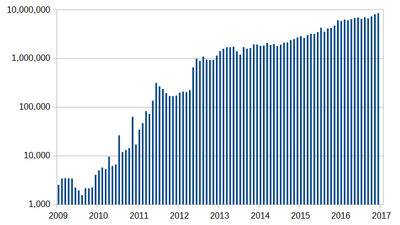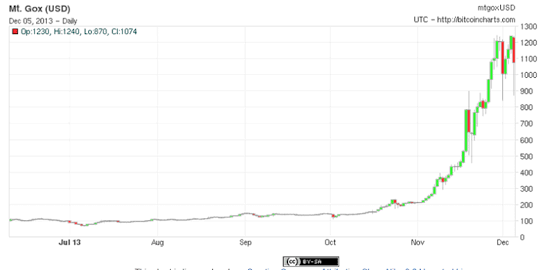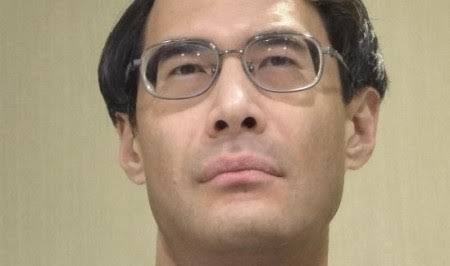BITCOIN History Startup
"Satoshi Nakamoto" is presumed to be a pseudonym for the person or people who designed the original bitcoin protocol in 2008 and launched the network in 2009. Nakamoto was responsible for creating the majority of the official bitcoin software and was active in making modifications and posting technical information on the BitcoinTalk Forum.[152] Investigations into the real identity of Satoshi Nakamoto were attempted by The New Yorker and Fast Company. The New Yorker's investigation brought up at least two possible candidates: Michael Clear and Vili Lehdonvirta. Fast Company's investigation brought up circumstantial evidence linking an encryption patent application filed by Neal King, Vladimir Oksman and Charles Bry on 15 August 2008, and the bitcoin.org domain name which was registered 72 hours later. The patent application (#20100042841) contained networking and encryption technologies similar to bitcoin's, and textual analysis revealed that the phrase "... computationally impractical to reverse" appeared in both the patent application and bitcoin's whitepaper.[11] All three inventors explicitly denied being Satoshi Nakamoto.[153][154] In May 2013, Ted Nelson speculated that Japanese mathematician Shinichi Mochizuki is Satoshi Nakamoto.[155] Later in 2013 the Israeli researchers Dorit Ron and Adi Shamir pointed to Silk Road-linked Ross William Ulbricht as the possible person behind the cover. The two researchers based their suspicion on an analysis of the network of bitcoin transactions.[156] These allegations were contested.[157] Ron and Shamir later retracted their claim.[158]
Nakamoto's involvement with bitcoin does not appear to extend past mid-2010.[159] In April 2011, Nakamoto communicated with a bitcoin contributor, saying that he had "moved on to other things".[160]
Stefan Thomas, a Swiss coder and active community member, graphed the time stamps for each of Nakamoto's 500-plus bitcoin forum posts; the resulting chart showed a steep decline to almost no posts between the hours of 5 a.m. and 11 a.m. Greenwich Mean Time. Because this pattern held true even on Saturdays and Sundays, it suggested that Nakamoto was asleep at this time, and the hours of 5 a.m. to 11 a.m. GMT are midnight to 6 a.m. Eastern Standard Time (North American Eastern Standard Time). Other clues suggested that Nakamoto was British: A newspaper headline he had encoded in the genesis block came from the UK-published newspaper The Times, and both his forum posts and his comments in the bitcoin source code used British English spellings, such as "optimise" and "colour".[161]
An Internet search by an anonymous blogger of texts similar in writing to the bitcoin whitepaper suggests Nick Szabo's "bit gold" articles as having a similar author.[7] Nick denied being Satoshi, and stated his official opinion on Satoshi and bitcoin in a May 2011 article.[162]
In a March 2014 article in Newsweek,

Bitcoin is a cryptocurrency, a digital asset designed to work as a medium of exchange that uses cryptography to control its creation and management, rather than relying on central authorities.[1] The presumed pseudonymous Satoshi Nakamoto integrated many existing ideas from the cypherpunk community when creating bitcoin.
In November 2008, a paper was posted to a cryptography mailing list[10] under the name Satoshi Nakamoto titled Bitcoin: A Peer-to-Peer Electronic Cash System. This paper detailed methods of using a peer-to-peer network to generate what was described as "a system for electronic transactions without relying on trust".[11][12][13][14] In January 2009, the bitcoin network came into existence with the release of the first open source bitcoin client and the issuance of the first bitcoins,[12][15][16][17] with Satoshi Nakamoto mining the first block of bitcoins ever (known as the genesis block), which had a reward of 50 bitcoins.
One of the first supporters, adopters, contributor to bitcoin and receiver of the first bitcoin transaction was programmer Hal Finney. Finney downloaded the bitcoin software the day it was released, and received 10 bitcoins from Nakamoto in the world's first bitcoin transaction.[18][19] Other early supporters were Wei Dai, creator of bitcoin predecessor b-money, and Nick Szabo, creator of bitcoin predecessor bit gold.[20]
In the early days, Nakamoto is estimated to have mined 1 million bitcoins.[21] Before disappearing from any involvement in bitcoin, Nakamoto in a sense handed over the reins to developer Gavin Andresen, who then became the bitcoin lead developer at the Bitcoin Foundation, the 'anarchic' bitcoin community's closest thing to an official public face.[22]
The value of the first bitcoin transactions were negotiated by individuals on the bitcointalk forums with one notable transaction of 10,000 BTC used to indirectly purchase two pizzas delivered by Papa John's.[12]
On 6 August 2010, a major vulnerability in the bitcoin protocol was spotted. Transactions weren't properly verified before they were included in the transaction log or blockchain, which let users bypass bitcoin's economic restrictions and create an indefinite number of bitcoins.[23][24] On 15 August, the vulnerability was exploited; over 184 billion bitcoins were generated in a transaction, and sent to two addresses on the network. Within hours, the transaction was spotted and erased from the transaction log after the bug was fixed and the network forked to an updated version of the bitcoin protocol.[25][26] This was the only major security flaw found and exploited in bitcoin's history.[23][24]
.png)
"Satoshi Nakamoto" is presumed to be a pseudonym for the person or people who designed the original bitcoin protocol in 2008 and launched the network in 2009. Nakamoto was responsible for creating the majority of the official bitcoin software and was active in making modifications and posting technical information on the BitcoinTalk Forum.[152] Investigations into the real identity of Satoshi Nakamoto were attempted by The New Yorker and Fast Company. The New Yorker's investigation brought up at least two possible candidates: Michael Clear and Vili Lehdonvirta. Fast Company's investigation brought up circumstantial evidence linking an encryption patent application filed by Neal King, Vladimir Oksman and Charles Bry on 15 August 2008, and the bitcoin.org domain name which was registered 72 hours later. The patent application (#20100042841) contained networking and encryption technologies similar to bitcoin's, and textual analysis revealed that the phrase "... computationally impractical to reverse" appeared in both the patent application and bitcoin's whitepaper.[11] All three inventors explicitly denied being Satoshi Nakamoto.[153][154] In May 2013, Ted Nelson speculated that Japanese mathematician Shinichi Mochizuki is Satoshi Nakamoto.[155] Later in 2013 the Israeli researchers Dorit Ron and Adi Shamir pointed to Silk Road-linked Ross William Ulbricht as the possible person behind the cover. The two researchers based their suspicion on an analysis of the network of bitcoin transactions.[156] These allegations were contested.[157] Ron and Shamir later retracted their claim.[158]
Nakamoto's involvement with bitcoin does not appear to extend past mid-2010.[159] In April 2011, Nakamoto communicated with a bitcoin contributor, saying that he had "moved on to other things".[160]
Stefan Thomas, a Swiss coder and active community member, graphed the time stamps for each of Nakamoto's 500-plus bitcoin forum posts; the resulting chart showed a steep decline to almost no posts between the hours of 5 a.m. and 11 a.m. Greenwich Mean Time. Because this pattern held true even on Saturdays and Sundays, it suggested that Nakamoto was asleep at this time, and the hours of 5 a.m. to 11 a.m. GMT are midnight to 6 a.m. Eastern Standard Time (North American Eastern Standard Time). Other clues suggested that Nakamoto was British: A newspaper headline he had encoded in the genesis block came from the UK-published newspaper The Times, and both his forum posts and his comments in the bitcoin source code used British English spellings, such as "optimise" and "colour".[161]
An Internet search by an anonymous blogger of texts similar in writing to the bitcoin whitepaper suggests Nick Szabo's "bit gold" articles as having a similar author.[7] Nick denied being Satoshi, and stated his official opinion on Satoshi and bitcoin in a May 2011 article.[162]
In a March 2014 article in Newsweek, journalist Leah McGrath Goodman doxed Dorian S. Nakamoto of Temple City, California, saying that Satoshi Nakamoto is the man's birth name. Her methods and conclusion drew widespread criticism.[163][164]
In June 2016, the London Review of Books published a piece by Andrew O'Hagan about Nakamoto.[165]
.jpg)
"Satoshi Nakamoto" is presumed to be a pseudonym for the person or people who designed the original bitcoin protocol in 2008 and launched the network in 2009. Nakamoto was responsible for creating the majority of the official bitcoin software and was active in making modifications and posting technical information on the BitcoinTalk Forum.[152] Investigations into the real identity of Satoshi Nakamoto were attempted by The New Yorker and Fast Company. The New Yorker's investigation brought up at least two possible candidates: Michael Clear and Vili Lehdonvirta. Fast Company's investigation brought up circumstantial evidence linking an encryption patent application filed by Neal King, Vladimir Oksman and Charles Bry on 15 August 2008, and the bitcoin.org domain name which was registered 72 hours later. The patent application (#20100042841) contained networking and encryption technologies similar to bitcoin's, and textual analysis revealed that the phrase "... computationally impractical to reverse" appeared in both the patent application and bitcoin's whitepaper.[11] All three inventors explicitly denied being Satoshi Nakamoto.[153][154] In May 2013, Ted Nelson speculated that Japanese mathematician Shinichi Mochizuki is Satoshi Nakamoto.[155] Later in 2013 the Israeli researchers Dorit Ron and Adi Shamir pointed to Silk Road-linked Ross William Ulbricht as the possible person behind the cover. The two researchers based their suspicion on an analysis of the network of bitcoin transactions.[156] These allegations were contested.[157] Ron and Shamir later retracted their claim.[158]
Nakamoto's involvement with bitcoin does not appear to extend past mid-2010.[159] In April 2011, Nakamoto communicated with a bitcoin contributor, saying that he had "moved on to other things".[160]
Stefan Thomas, a Swiss coder and active community member, graphed the time stamps for each of Nakamoto's 500-plus bitcoin forum posts; the resulting chart showed a steep decline to almost no posts between the hours of 5 a.m. and 11 a.m. Greenwich Mean Time. Because this pattern held true even on Saturdays and Sundays, it suggested that Nakamoto was asleep at this time, and the hours of 5 a.m. to 11 a.m. GMT are midnight to 6 a.m. Eastern Standard Time (North American Eastern Standard Time). Other clues suggested that Nakamoto was British: A newspaper headline he had encoded in the genesis block came from the UK-published newspaper The Times, and both his forum posts and his comments in the bitcoin source code used British English spellings, such as "optimise" and "colour".[161]
An Internet search by an anonymous blogger of texts similar in writing to the bitcoin whitepaper suggests Nick Szabo's "bit gold" articles as having a similar author.[7] Nick denied being Satoshi, and stated his official opinion on Satoshi and bitcoin in a May 2011 article.[162]
In a March 2014 article in Newsweek, journalist Leah McGrath Goodman doxed Dorian S. Nakamoto of Temple City, California, saying that Satoshi Nakamoto is the man's birth name. Her methods and conclusion drew widespread criticism.[163][164]
"Satoshi Nakamoto" is presumed to be a pseudonym for the person or people who designed the original bitcoin protocol in 2008 and launched the network in 2009. Nakamoto was responsible for creating the majority of the official bitcoin software and was active in making modifications and posting technical information on the BitcoinTalk Forum.[152] Investigations into the real identity of Satoshi Nakamoto were attempted by The New Yorker and Fast Company. The New Yorker's investigation brought up at least two possible candidates: Michael Clear and Vili Lehdonvirta. Fast Company's investigation brought up circumstantial evidence linking an encryption patent application filed by Neal King, Vladimir Oksman and Charles Bry on 15 August 2008, and the bitcoin.org domain name which was registered 72 hours later. The patent application (#20100042841) contained networking and encryption technologies similar to bitcoin's, and textual analysis revealed that the phrase "... computationally impractical to reverse" appeared in both the patent application and bitcoin's whitepaper.[11] All three inventors explicitly denied being Satoshi Nakamoto.[153][154] In May 2013, Ted Nelson speculated that Japanese mathematician Shinichi Mochizuki is Satoshi Nakamoto.[155] Later in 2013 the Israeli researchers Dorit Ron and Adi Shamir pointed to Silk Road-linked Ross William Ulbricht as the possible person behind the cover. The two researchers based their suspicion on an analysis of the network of bitcoin transactions.[156] These allegations were contested.[157] Ron and Shamir later retracted their claim.[158]
Nakamoto's involvement with bitcoin does not appear to extend past mid-2010.[159] In April 2011, Nakamoto communicated with a bitcoin contributor, saying that he had "moved on to other things".[160]
Stefan Thomas, a Swiss coder and active community member, graphed the time stamps for each of Nakamoto's 500-plus bitcoin forum posts; the resulting chart showed a steep decline to almost no posts between the hours of 5 a.m. and 11 a.m. Greenwich Mean Time. Because this pattern held true even on Saturdays and Sundays, it suggested that Nakamoto was asleep at this time, and the hours of 5 a.m. to 11 a.m. GMT are midnight to 6 a.m. Eastern Standard Time (North American Eastern Standard Time). Other clues suggested that Nakamoto was British: A newspaper headline he had encoded in the genesis block came from the UK-published newspaper The Times, and both his forum posts and his comments in the bitcoin source code used British English spellings, such as "optimise" and "colour".[161]
An Internet search by an anonymous blogger of texts similar in writing to the bitcoin whitepaper suggests Nick Szabo's "bit gold" articles as having a similar author.[7] Nick denied being Satoshi, and stated his official opinion on Satoshi and bitcoin in a May 2011 article.[162]
In a March 2014 article in Newsweek, journalist Leah McGrath Goodman doxed Dorian S. Nakamoto of Temple City, California, saying that Satoshi Nakamoto is the man's birth name. Her methods and conclusion drew widespread criticism.[163][164]
In June 2016, the London Review of Books published a piece by Andrew O'Hagan about Nakamoto.[165]
.jpg)
.jpg)
.jpg)
good content ,keep posting upvoted and followed you do the same thank you
upvoted and followed you if you like salaheldeen0 please upvoted and follow me lets help each other :)